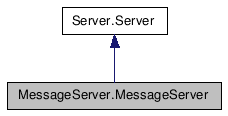MessageServer.MessageServer Class Reference
#include
<class_message_server_1_1_message_server.h>

Public Member Functions |
|
| __init__ () | |
| sendMessage () | |
| Overrides MessageSender.sendMessage().
|
|
| setDocument () | |
| broadcastMessage () | |
| Broadcasts the given message to the clients
with the given IDs. |
|
| registerRemoteClient () | |
| Adds the given client to the list of managed
connected clients returns the generated client ID. |
|
| handleRemoteClientData () | |
| Accepts messages from the clients and queue
them onto the server message queue. |
|
| frameSyncAllClients () | |
| Called from the application thread, this
method will wait until the server thread has received an
acknowledging frame start message from all active clients before
returning. |
|
| deregisterRemoteClient () | |
| Queue a message about the client that is
diconnecting. |
|
| addSyncClient () | |
| removeSyncClient () | |
Member Function Documentation
| MessageServer.MessageServer.__init__ | ( | ) |
Reimplemented from Server.Server.
| MessageServer.MessageServer.sendMessage | ( | ) |
Overrides MessageSender.sendMessage().
If a message queue was provided in the constructor, the message is placed on that queue. Otherwise, MessageSender.sendMessage() is used.
| MessageServer.MessageServer.setDocument | ( | ) |
| MessageServer.MessageServer.broadcastMessage | ( | ) |
Broadcasts the given message to the clients with the given IDs.
| MessageServer.MessageServer.registerRemoteClient | ( | ) |
Adds the given client to the list of managed connected clients returns the generated client ID.
Sends an acknowledgement message with a new ID to the new client, and informs already connected clients and the server of the new client.
Reimplemented from Server.Server.
| MessageServer.MessageServer.handleRemoteClientData | ( | ) |
Accepts messages from the clients and queue them onto the server message queue.
NOTE: this method is called from the socket handling thread (see ClientConnection) asynchronously with the main message handling thread. Interaction with other threads should be through messaging or some other appropriately synchronized mechanism.
Reimplemented from Server.Server.
| MessageServer.MessageServer.frameSyncAllClients | ( | ) |
Called from the application thread, this method will wait until the server thread has received an acknowledging frame start message from all active clients before returning.
The timeout argument indicates how long we're willing to wait (in seconds) with zero indicating no timeout.
| MessageServer.MessageServer.deregisterRemoteClient | ( | ) |
Queue a message about the client that is diconnecting.
Since this is a broadcastable message, all other clients will get notified as well. Notifies a server about the client that is disconnecting.
Reimplemented from Server.Server.
| MessageServer.MessageServer.addSyncClient | ( | ) |
| MessageServer.MessageServer.removeSyncClient | ( | ) |
